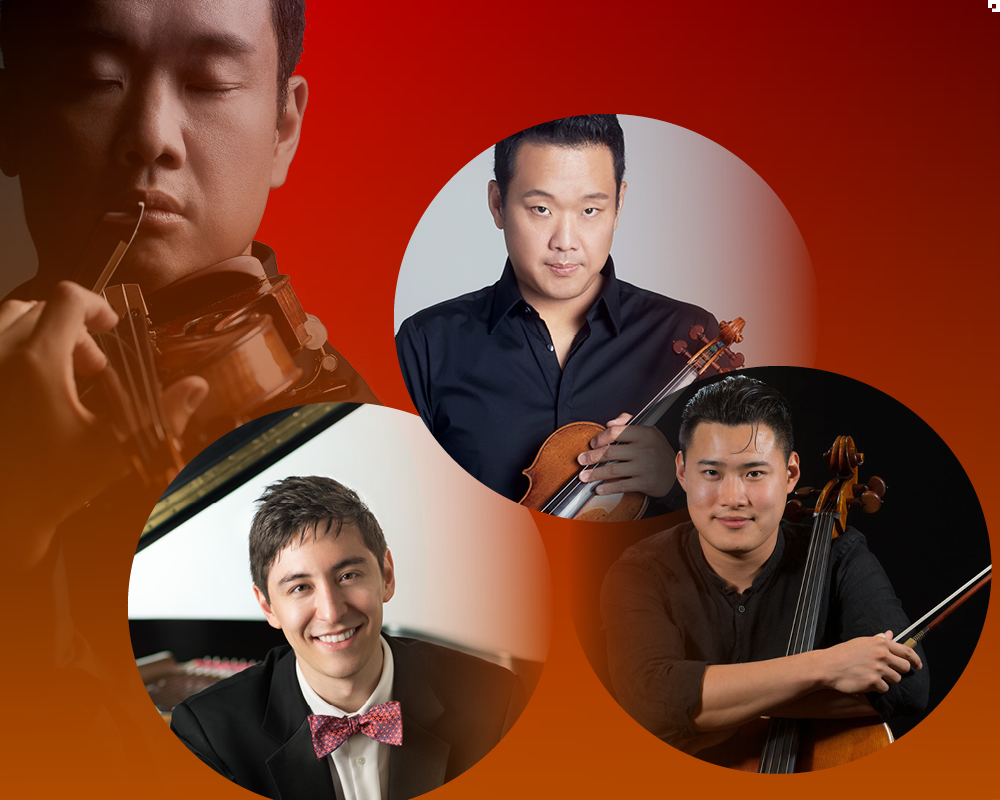
Trio Barclay
Sunday, November 21, 2021 at 5pm
presented by Irvine Barclay Theatre
Artist Sponsor:
Brian and Yun Kyung Chung
This performance will include one 15-minute intermission.
Trio Barclay
Dennis Kim: violin
Jonah Kim: cello
Sean Kennard: piano
Out the Other Side
Composer: Mark Abel
(2021)
Cafe Music
Composer: Paul Schoenfield
(1987)
I. Allegro
II. Rubato, andante moderato
III. Presto
Intermission
Piano Trio No. 1 in B major, Op. 8
Composer: Johannes Brahms
(1854)
I. Allegro con brio
II. Scherzo. Allegro molto
III. Adagio
IV. Finale. Allegro
Out the Other Side
Composer: Mark Abel
(2021)
"This is the third trio I’ve composed in recent years, but the first that utilizes the form’s traditional instrumentation of violin, cello and piano. I’ve tried to approach this model in a fresh way, striving for the sense of an organic journey and steering away from virtuosic display and long-windedness.
Though its running time is just under 10 minutes, I feel that the piece covers a goodly amount of ground as it coils and uncoils a series of linked emotional episodes. The expansion and contraction eventually points toward the need for a cathartic release (an imperative familiar to most composers). In this case, however, I was drawn to a type of coda I’ve never previously explored: A rollicking dance to the finish line, as the trio’s forward momentum is finally shot 'out the other side.'" – Mark Abel
Cafe Music
Composer: Paul Schoenfield
(1987)
"The idea to compose Café Music first came to me in 1985 after sitting in one night for the pianist at Murray’s Restaurant in Minneapolis, Minnesota. Murray’s employs a house trio that plays entertaining dinner music in a wide variety of styles. My intention was to write a kind of high-class dinner music – music which could be played at a restaurant, but might also (just barely) find its way into a concert hall. The work draws on many of the types of music played by the trio at Murray’s. For example, early 20th-century American, Viennese, light classical, gypsy, and Broadway styles are all represented. A paraphrase of a beautiful Chassidic melody is incorporated in the second movement." – Paul Schoenfield
Café Music was commissioned by the St. Paul Chamber Orchestra (SPCO) and received its premiere during a SPCO chamber concert in January 1987 with Schoenfield at the piano.
Piano Trio No. 1 in B major, Op. 8
Composer: Johannes Brahms
(1854)
In 1854, laboring under the "curse" of Schumann's glowing predictions for Germany's new rising star, a young twenty-one year old Brahms decided to publish his first chamber composition, the Piano Trio in B major, Op. 8. This was no small undertaking: Brahms was a fierce self-critic and is known to have consigned several early chamber works to the fire. Thirty-five years later, in 1890, with all but a few final works ahead, the mature, master Brahms returned to the same trio compelled to revise. With his characteristic humor, Brahms claimed, "I didn't provide it with a new wig, just combed and arranged its hair a little." His changes were in fact substantial: he shortened the work by about one-third, significantly modifying all but the scherzo. It was around this time that Brahms decided to retire, after which he was coaxed momentarily by a late affair with the clarinet into a final small set of compositions. This piano trio therefore has a special significance for Brahms the chamber composer: it began his public career and it preoccupied his attentions again at the end of an astonishing series of masterpieces. In its final form, the B major piano trio bears the hand, the mind and the heart of both the young and the elder Brahms.
Though an early work, the first of his three piano trios is unmistakably Brahms. Lasting nearly half of its total duration, the first movement is a massive sonata beginning with a beautiful theme in the cello, jarred by violent contrast and escalating into a mountain of dramatic development. A restless, dark character dominates most of the trio from the first movement's secondary themes to the brooding march of the scherzo to the wind-blown sweep of the finale rondo. While the light of B major frequently breaks through, the majority of the Trio gravitates to minor related keys, ending, despite the suggestions of its title, on a solid b minor chord. Typical of Brahms, the textures are thick, frequently juxtaposing the heavy romantic piano with the strings, violin and cello unified in a variety of parallel harmonies and symmetric counter motions.
To counterbalance such weight, Brahms offers the third movement adagio, a slow movement of such repose that it seems to hover, nearly motionless, an introspective intermezzo from another world. The lightest movement in multiple senses of the word, it is perhaps the most emotionally compelling, certainly, the most peculiar. The soft musical meditation focuses primarily on the piano with echoing commentary by an ethereal chorus of strings. The central section of its ternary form gathers into a tender, melancholy song first in the cello, passing to the piano and the violin across interludes that are somber, even haunting. Ephemeral, the concrete diffuses again into the abstract, the reappearance of the now familiar beginning transforming the indefinite into the transcendent.
© Kai Christiansen. Used by permission. All rights reserved.

